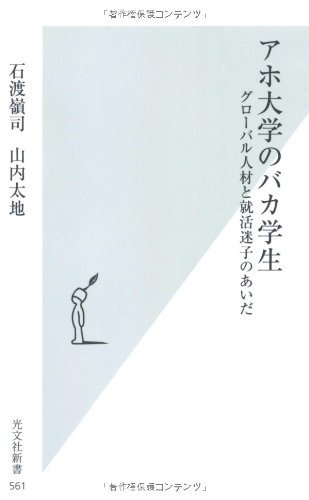4 0 0 0 アホ大学のバカ学生 : グローバル人材と就活迷子のあいだ
- 著者
- 石渡嶺司 山内太地著
- 出版者
- 光文社
- 巻号頁・発行日
- 2012
本研究は、1940年代後半以降、長年、貧困/生活困窮当事者による社会保障運動として全国各地で活動を続けている「生活と健康を守る会」(以下、守る会)に光を当て、貧困当事者の<声>の政治の一端を明らかにしようとするものである。そのために、守る会による発行物の分析、そして「守る会」運動に深くコミットしてきた関係者への聞き取り・語りの分析を行う。これらの作業を通して、戦後日本において、とりわけ貧困/生活困窮当事者の手になる運動が、①どのように当事者の組織化を行い、②ボトムアップ型の社会保障政策形成を促し、③貧困当事者中心のソーシャルワーク実践に影響を与えたのかの三点を実証的に明らかにしたい。
2 0 0 0 OA 子どもの身体に異変が起きている ―世界の子どもの体格・体力の現状と時代変化―
- 著者
- 山内 太郎
- 出版者
- 日本健康学会
- 雑誌
- 日本健康学会誌 (ISSN:24326712)
- 巻号頁・発行日
- vol.83, no.6, pp.174-183, 2017-11-30 (Released:2017-12-25)
- 参考文献数
- 23
- 被引用文献数
- 3 2
Childhood obesity and physical fitness are increasing and decreasing among children in developed countries, respectively; this has become an international social problem. Recently, this tendency has appeared in the Asian region, particularly among urban-dwelling children in locations experiencing rapid economic development. After the Second World War, Japan experienced the earliest economic development in Asia; this led to intergenerational changes in body size and physical fitness among Japanese children. Japanese children’s current physical status may thus predict that of children in other Asian countries.We reviewed Japanese children’s physical fitness and anthropometric data using nationally repre sentative surveys and comparing generations (e.g., grandparents vs. parents vs. children) to exam ine secular trends. As expected, currently, children are taller and heavier than parent-aged individu als were at the same age and the prevalence of obesity increased compared with 30 years ago.Nonetheless, during the past decade, body weight and obesity have decreased. Current children are less physically fit than their parents’ generation was at the same age. Additionally, school nurses and PE teachers are increasingly reporting lifestyle-related diseases, injuries of the head and face, frac tures, and decreasing muscle strength among school children.Finally, we present a small-scale study of lifestyle and behavior patterns among hunter-gatherer children living in African tropical forests and discuss ways to prevent child obesity and improve chil dren’s physical fitness and health.
2 0 0 0 IR 幕末期,水害と闘うある村落指導者に関する覚書 : 越後西蒲原郡中郷屋村を事例として
- 著者
- 山内 太 Futoshi YAMAUCHI 京都産業大学経済学部
- 雑誌
- 京都産業大学総合学術研究所所報 (ISSN:13488465)
- 巻号頁・発行日
- no.7, pp.79-90, 2012-07
本稿は,幕末期に,水害と闘ったある村落指導者・苗木家に関する物語である。18世紀以来中郷屋村の庄屋を務めていた苗木家は,中郷屋村のみならず,村を超えて,西蒲原地域において,代々活動してきた。そして幕末期には,藩や地域社会に,地域指導者としての役割を期待される存在となっていた。そして彼らは、藩や地域社会の期待に応えていた,ということを明らかにした。
1 0 0 0 OA 農業用移動ロボットの自動充電システム
- 著者
- 井小萩 湧 高橋 庸平 北澤 椋太 鳥山 渓太 小林 稜平 小山内 太郎 ミヤグスク レナート 尾崎 功一
- 出版者
- 自動制御連合講演会
- 雑誌
- 自動制御連合講演会講演論文集 第65回自動制御連合講演会
- 巻号頁・発行日
- pp.530-532, 2022 (Released:2022-12-15)
1 0 0 0 OA 子どもの貧困に関する総合的研究:貧困の世代的再生産の過程・構造の分析を通して
- 著者
- 松本 伊智朗 湯澤 直美 関 あゆみ 蓑輪 明子 永野 咲 加藤 弘通 長瀬 正子 丸山 里美 大谷 和大 岩田 美香 大澤 亜里 鳥山 まどか 佐々木 宏 杉田 真衣 山野 良一 田中 智子 上山 浩次郎 藤原 千沙 吉中 季子 福間 麻紀 大澤 真平 藤原 里佐 川田 学 谷口 由希子 中澤 香織 伊部 恭子 山内 太郎 新藤 こずえ 小西 祐馬 加藤 佳代
- 出版者
- 北海道大学
- 雑誌
- 基盤研究(A)
- 巻号頁・発行日
- 2016-04-01
本研究の目的は、子どもの貧困の現代的特質を明らかにすると同時に、政策的介入と支援のあり方を検討することである。そのために、大規模な子ども・家族を対象とした生活調査(3万人対象)を北海道で行った。あわせて、女性の貧困に関する理論的検討、社会的養護経験者に対する調査を行った。それらを通して、経済的問題、時間の確保、追加的ケアへの対応、ジェンダー平等の重要性、子どもの活動と経験、社会的ケアと社会保障制度の問題について検討を行った。
- 著者
- 山内 太郎
- 出版者
- 総合地球環境学研究所
- 雑誌
- 国際共同研究加速基金(国際共同研究強化(B))
- 巻号頁・発行日
- 2019-10-07
- 著者
- 緑川 泰史 山内 太郎 石森 大知 大塚 柳太郎
- 出版者
- The Japanese Society of Health and Human Ecology
- 雑誌
- 民族衛生 (ISSN:03689395)
- 巻号頁・発行日
- vol.69, no.4, pp.132-142, 2003-07-31 (Released:2010-06-28)
- 参考文献数
- 21
Seasonality of nutrient intake was evaluated by 7-successive-day food consumption survey in the ordinary season (March) and the slack season (June) of fish catch among 13 married couples in a Solomon Islands society, who were engaged in traditional horticulture and fishing, together with time allocation study. Males' time spent in gardening and fishing was significantly shorter in June than in March (gardening: -48 min/d, and fishing: -43 min/d; P<0 .05, respectively), while there was no seasonal difference in females. On the other hand, males spent more time in hunting and marketing, and females in particular did more time in marketing (P<0.01). No significant difference in energy intake between March and June was observed for either sex. The protein intake was significantly lower in June than in March (males: -23.9 g/d, P<0.01; females: -12.0 g/d, P<0.05). The males' fat intake was significantly higher in June than in March (+14.8 g/d, P<0.05), thought not significantly in females. To compensate the smaller amount of fish catch in June, the villagers spent more time in hunting and marketing, and they took larger amounts of coconut and a kind of nut, which abounds with fat . This study thus suggested that changes in food obtaining activities and food intake patterns of the villagers played significant roles to cope with seasonal shortage of fish catch.
1 0 0 0 OA 透析患者のQOL向上を実現するアクティブライフスタイル教育プログラムの開発と運用
包括的な栄養アセスメントにより、血液透析患者の栄養状態・ QOLの維持向上の方策として、透析日の生活活動と亜鉛摂取量の増加が重要であることを見出し、透析中に行う低強度運動プログラム(ストレッチ・マッサージ)を開発した。このプログラムは、患者の身体能力や意欲に応じて選択可能な段階的コースを用意するとともに、患者が自己の最適ペースで実施できるよう、教育メディア(DVD)を制作した。また、亜鉛強化菓子を考案し、透析後に提供して栄養指導の動機づけとするダイエットプログラムを開発した。これらのプログラムの介入効果として、患者の貧血改善や下肢の筋肉量の増加、身体機能の向上が示唆された。
1 0 0 0 OA 市場経済形成期における村落的共同性の日欧比較研究
本研究では、17~19世紀近世日本における村落社会(長野県上塩尻村ほか)を基準として、16~18世紀におけるイングランド村落社会(ケンブリッジシャー)と北西ドイツ村落社会(東部北海沿岸地方)とについて、現地の研究者の協力を得て、実証的比較研究を行った。近世日本村落を構成した共同性の重層的構造からみると、16~18世紀の英独両農村社会の事例については、史料制約性による直接比較の困難性があり、従来共同体とされてきた「村落」や「家族」についての再解釈が必要であり、従来親族ネットワークやサーバント制度、そしてマルク共同体等土地共有共同体の再検討が必要であることが確認された。
1 0 0 0 都市環境が住民の日常身体活動に及ぼす影響に関する調査研究
本研究は、国内で初めて客観的な物理的環境指標による居住地域環境が人々の身体活動行動に及ぼす影響を明らかにすることを目的とした。研究初年度の文献研究の結果、複数地域の複数集団を対象とすること、居住地域環境因子としては客観的、主観的な種々の因子についての検討が必要であること、身体活動については各種構成要素(移動・余暇・総身体活動)を包括的に網羅した検討が必要であることが明らかになった。身体活動に影響を及ぼす可能性のある居住地域環境の評価法としては、物理的環境をGIS(Geographic Information System)を用いた客観的な方法による実測で評価する方法と、住民の主観的認知指標調査法によって評価する方法を提案することができた。作成したGISデータベースによって、地域環境指標(世帯数、道路総延長、土地利用状況など)を対象者ごとに数値化することが可能であった。住民側の環境認知を評価する質問紙としてはAbbreviated Neighborhood Environment Walkability Scale(ANEWS)日本語版を作成し、国際比較も可能とした。住民の日常身体活動量は加速度計、歩数計等を用いた客観的な測定と、身体活動量調査票(International Physical Activity Questionnaire)による方法を用いて、その妥当性を検討した。文化的・社会的背景の異なる国内地域として、都心部1ヶ所、地方都市2ヶ所において、身体活動を推進する物理的環境要因について検討した。居住地域環境と身体活動との関連は、地域や性別による違いがみられた。住民の身体活動を推進する都市基盤整備には、地域の特性を活かした進め方が必要と考えられた。さらに、個人の行動パターンを時間、位置、身体活動レベルの3つの側面から関連づけて分析するために、小型GPS(汎地球測位システム)と加速度計を同時に装着し、GISとともに3つのデータを統合する方法を提案した。今後はこのシステムを利用することで都市の土地利用分類ごとの身体活動パターンの特徴を明らかにし、健康増進につながる都市空間創造の基礎データを蓄積することが可能になる。
研究実施計画書にしたがい、本年度も文献調査およびフィールドワークを行った。文献調査は、現代に生きる狩猟採集民、伝統的漁撈民・農耕民の先行研究に加えて都市居住者(先進国および発展途上国)を収集し、体格・栄養摂取量・身体活動量のデータを分析した。また霊長類、先史人類の考古学的研究についても、方法論の違いに注意を払いながらデータ収集、分析を行った。データ分析、とくに方法論の違うデータの比較・統合について利用可能性の高い手法について学んだ。フィールドワークは、研究計画書に記載したとおり、インドネシア共和国の都市居住者(中部ジャワ州の州都スマラン市)について、とくに子どもの肥満に焦点をあてて測定調査を行った。また、コミュニティー全体を対象とした調査としては、南太平洋ソロモン諸島の首都近郊の村居住者を対象として調査を行った。調査内容は、1)身体計測・血圧測定、2)食物摂取量調査、3)安静時代謝量測定、4)身体活動量測定であった。成果発表としては、計画書に記載した通り、国際学会(14^<th> European Congress on Obesity, Athens, Greece)で発表した。また、インドネシア共和国中部ジャワ州のDiponegoro大学において招待講演を行った。さらに日本相撲協会主催の相撲医学研究会で発表を行った。今後、国際学会発表(10^<th> International Congress on Obesity, Sydney, Australia)を予定している。発表論文(別紙参照)としては、国内高齢者の身体活動量とフィットネス、パプアニューギニア高地民の農村居住者と都市移住者の身体活動量および体格・体組成に関する比較研究をはじめとして、海外の研究者と協力してアフリカ(カメルーン)狩猟採集民、日本人大学相撲選手、中国都市部および農村部の学童、トンガ王国の思春期の少年少女について公刊した。

